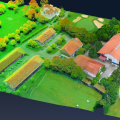
Minerals and energy resource explorers will have access to pre-competitive data in unprecedented detail following a collaborative project between Geoscience Australia and the National Computational Infrastructure (NCI) Facility.
Using the NCI supercomputer operated at the Australian National University, geologists from Geoscience Australia have developed high-resolution 3D images of sub-surface geology, which eliminate the often degraded resolution and scales in models generated with traditionally limited computing power.
Geologist James Goodwin told the International Geological Congress in Brisbane last week that data from the national gravity and magnetic anomaly maps of Australia use geophysical inversion software developed by the University of British Columbia to achieve the high definition models.
“High-resolution models covering an area of 240 square kilometres and containing 6.48 million cells can now take as little 30 minutes to process,” he said.
“Models have already been built successfully for offshore and onshore areas in Western Australia, with the onshore model supporting interpretation of deep seismic survey data identifying features separating the Pilbara, Capricorn and Yilgarn geological regions,” Mr Goodwin said.
“The improved data quality will allow minerals and energy resource explorers and mining companies to more accurately identify specific areas with resource potential,” he said
The Chief of Geoscience Australia’s Minerals and Natural Hazards Division, Dr Andy Barnicoat said that creation of models that remove the effect of anomalies outside the specific area of interest will greatly reduce the exploration risk for mining and exploration companies.
“The NCI supercomputing capacity will have wide ramifications for industry and for other activities such as natural hazard mitigation and land-use planning,” Dr Barnicoat said.







